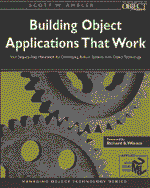 Building Object Applications that Work
Building Object Applications that Work Book contents
- Frontmatter
- Contents
- About the Author
- Foreword
- Preface
- Acknowledgments
- Part I INTRODUCTION TO BUILDING OBJECT APPLICATIONS
- Chapter 1 Where We've Been Before—Object-Oriented Concepts and Techniques
- Part II OBJECT-ORIENTED ANALYSIS, DESIGN, AND ARCHITECTURE
- Part III OBJECT-ORIENTED CONSTRUCTION
- Part IV OBJECT-ORIENTED TESTING
- Part V CONCLUSION
- APPENDICES
- Index
Chapter 1 - Where We've Been Before—Object-Oriented Concepts and Techniques
from Part I - INTRODUCTION TO BUILDING OBJECT APPLICATIONS
Published online by Cambridge University Press: 07 September 2010
- Frontmatter
- Contents
- About the Author
- Foreword
- Preface
- Acknowledgments
- Part I INTRODUCTION TO BUILDING OBJECT APPLICATIONS
- Chapter 1 Where We've Been Before—Object-Oriented Concepts and Techniques
- Part II OBJECT-ORIENTED ANALYSIS, DESIGN, AND ARCHITECTURE
- Part III OBJECT-ORIENTED CONSTRUCTION
- Part IV OBJECT-ORIENTED TESTING
- Part V CONCLUSION
- APPENDICES
- Index
Summary
What We'll Learn in This Chapter
Object-oriented concepts, including a few that we missed in The Object Primer.
Modeling techniques like class responsibility collaborator (CRC) modeling, use-case scenario testing, and class diagramming.
An iterative development life cycle called “The Pinball System Development Life Cycle (SDLC).”
What this book is all about.
Unless you're reading The Object Primer and Building Object Applications That Work back to back you're going to need a quick refresher. Furthermore, there's some new material in this chapter starting in section 1.3 (hey, like we'd want you to skip an entire chapter).
Until the release of this book, The Object Primer was the greatest thing since time-sliced bread. Now we have Building Object Applications, a book that is even more spectacular than its predecessor. In The Object Primer we covered analysis techniques such as class responsibility collaborator (CRC) modeling and use-case scenario testing. We also introduced several object-oriented (OO) concepts and showed you how to model them using class diagrams. We finally put all this into the context of the Pinbail System Development Life cycle (SDLC), an iterative and incremental approach to OO systems development.
Object-Oriented Concepts — A Really Quick Recap
In The Object Primer we introduced you to several concepts that are critical to understanding the OO development process. Let's invest a few minutes reviewing the following object-oriented concepts:
Objects
Classes
Attributes
Methods
Abstraction
Encapsulation
Information hiding
Inheritance
Persistence
Instance relationships
Aggregation
Collaboration
Coupling
Cohesion
Polymorphism
Information
- Type
- Chapter
- Information
- Building Object Applications that WorkYour Step-by-Step Handbook for Developing Robust Systems with Object Technology, pp. 3 - 46Publisher: Cambridge University PressPrint publication year: 1997